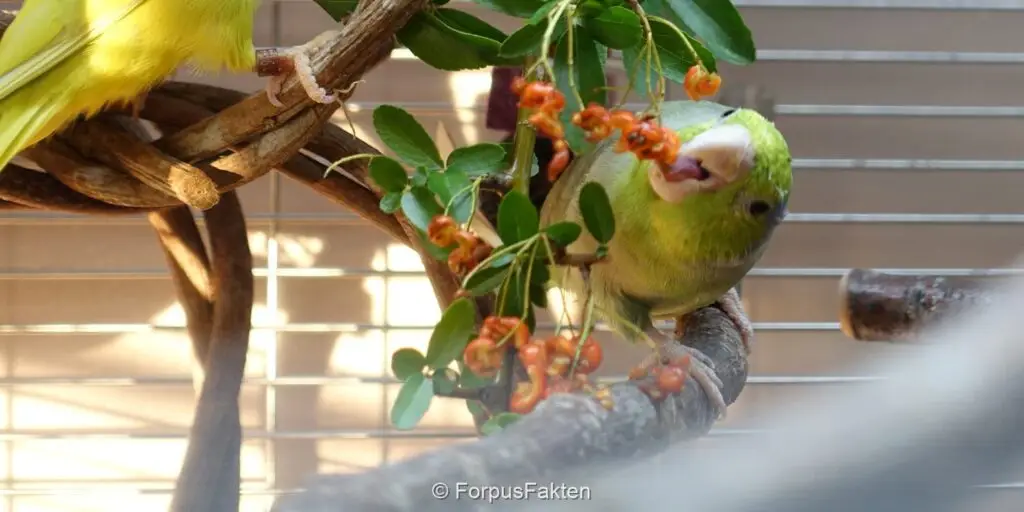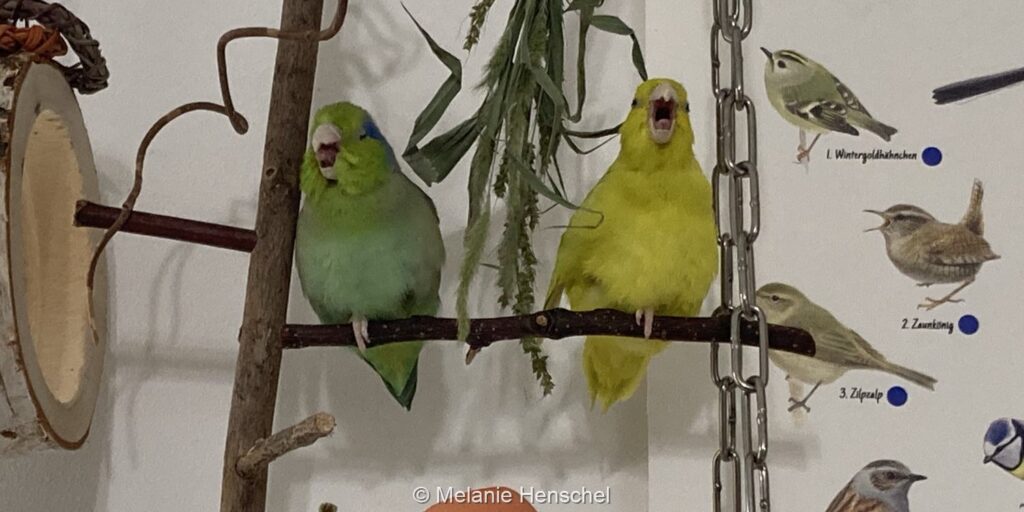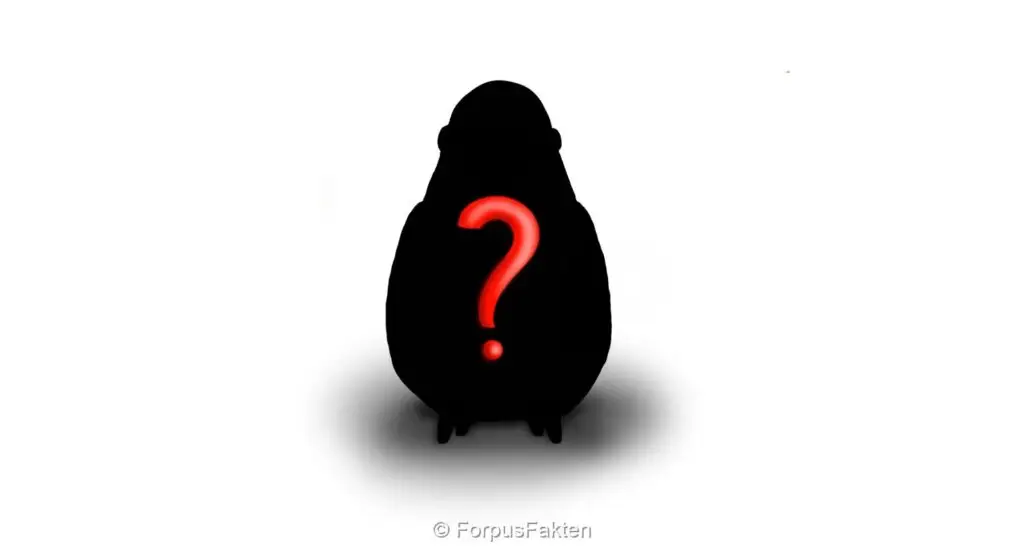Next to the question of what to feed, the question of how often comes up short. However, the presentation of food is just as important as its composition.
The basic goal of species-appropriate feeding is (apart from the type and composition of the feed) a presentation that is as close to nature as possibleWild parrots spend the majority of their day foraging for food and eating, on average at least half of the day. Assuming a 12-hour day, this adds up to at least 6 hours a day.
If we only feed seeds and fresh food from bowls, this task is accomplished within a couple of minutes. According to scientific research, parrots in captivity spend approximately half an hour to an hour feeding and foraging, that equals appr. 4.8% of the day. Apart from preening and social interactions, the bird has nothing to do for the rest of the day. Despite provided toys, boredom is inevitable this way, which can lead to a series of abnormal behaviour like feather plucking, stereotypical behaviour, aggressiveness and more, as well as obesity and muscle atrophy . In Addition, boredom or mental underload are big risk factors when it comes to your birds' mental health and wellbeing .
So food should be presented in a way that engages your birds for as long as possible. Easier said than done. As to that, first, you have to know one essential basis: Our pet birds have usually grown up at breeders who mostly use breeding boxes and normally only feed the adult animals from bowls to cover the high energy demand of raising offspring as efficiently as possible. That is why most birds bred in Europe have little to no experience with natural foraging. Although some instincts take over here, foraging has to be learned.

Therefore, the switch from feeding from bowls to foraging has to be done step by step. In addition, you have to make sure that the basic food supply is ensured at all times. For example, in the beginning it makes sense to only use treats for foraging while still supplying the basic feed from bowls. In general, you can follow the rule of thumb: The unhealthier/richer the food, the more it should be worked for. For instance, since most parrotlets prefer seeds over fruits and vegetables, the latter should be provided in an easily accessible way while you can make your birds work for their seeds with an easy conscience.
Foraging
But what can foraging look like in practice? There are hardly any limits to your imagination here. For inspiration, I recommend watching videos of wild parrotlets searching for food.
Here, you can see that parrotlets climb around on branches and sometimes dizzyingly thin twigs to reach fruits, berries and seed heads from which seds have to be extracted, the nibble seeds from panicles and cobs which, first, have to be searched on the plant, they go on the ground to look for seeds in the sand and under stones or feed directly from seed-bearing grasses and other plants, they nibble on the greenery, fly and climb from one food source to another and most importantly: Every day, they first have to look where there is food to be found in the first place.
From this we can derive a multitude of different possibilities for presenting food to our pet birds in a similar way. Let's look at this systematically:
Climbing around (thin) branches
This can quite easily be copied by hanging food, on the plant, in small bowls or on skewers, where it can only be reached via small, thin branches or the cage grid.
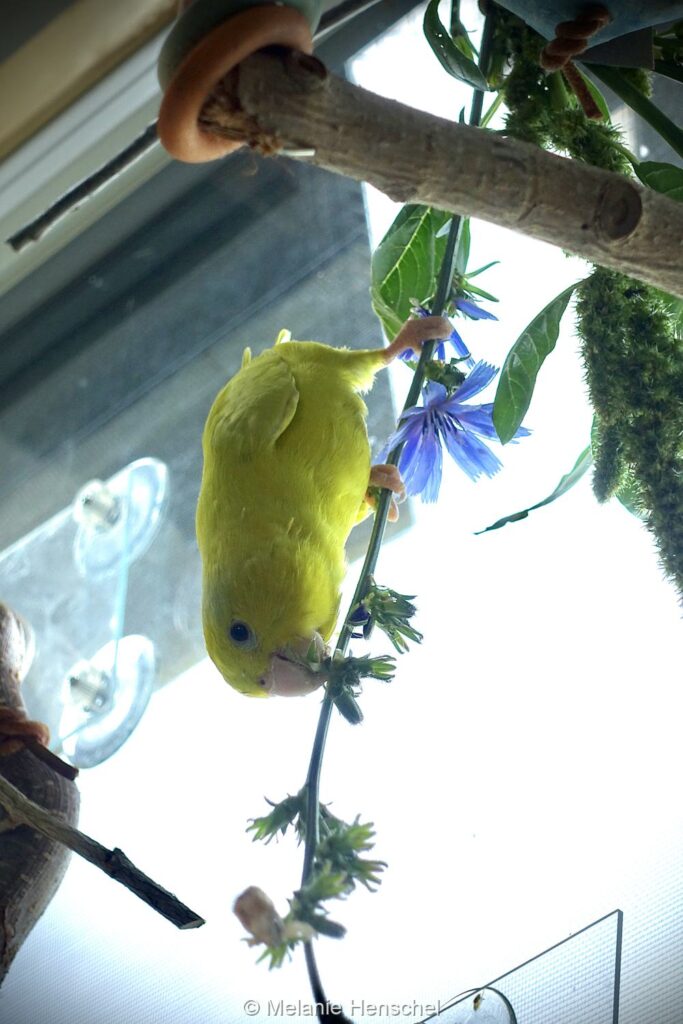
Extracting seeds/kernels from fruits or shells
For one thing, you can of course directly copy this by feeding berries, vegetables with seeds (e.g. cucumber, zucchini, melon, pumpkin, bell pepper) or fruit with seeds (e.g. kiwi, pitaya, fig). Besides that usually creates a superb mess.
For another thing, you can simulate this by hiding food e.g. in finger traps, willow balls, small boxes made from paper, carton, palm leaf or similar materials.
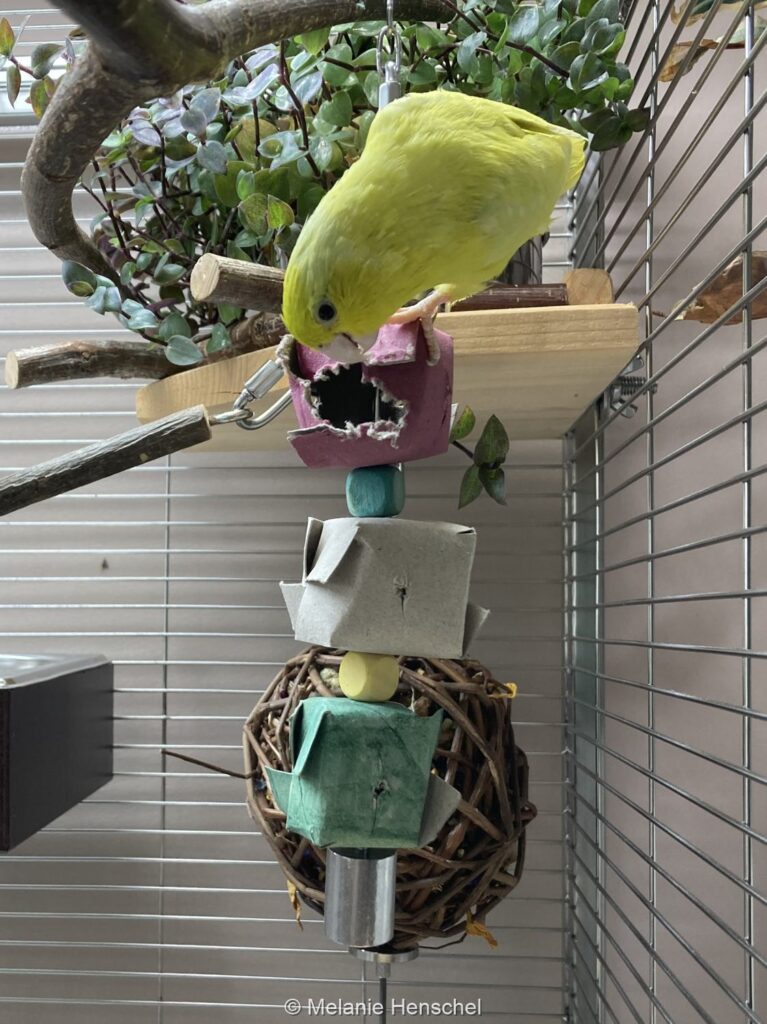
Eating seeds directly off the plant
In the upcoming food-plant database, you can read which food plants exactly can be used for this. In any case, you should not limit yourself to millet since it is very rich and has a relatively low enrichment value compared to alternatives. Above all, half-ripe grasses are as popular as they are healthy.

Looking for food on the plant
For real foraging you shouldn't hang a bouquet of grasses and be done with it. The grasses (or other food) should rather be broken up into pieces and attached in different places or your bird's territory. On top of that, this has the advantage that it leads to less fights over food.
Going on the ground
Keeping birds in cages, feed should not be foraged on the ground per se since this will lead to contamination with the birds' own dropping which is unhygienic and promotes diseases. A better way is to provide separate areas which can be kept clean. The easiest option is to spread loose food e.g. on platforms inside the cage or outside the cage on windowsills which then can be foraged by your birds. However, it won't take long until our clever parrotlets are not sufficiently engaged by this anymore. That is why digging boxes are a popular solution. These can be filled with bird sand, wood chips, dried herbs and blossoms, cones, pebbles and much more. Simply spread some pellets, seeds, dried berries or other dry food over this. Now the birds have to dig in the substrate to find the food.
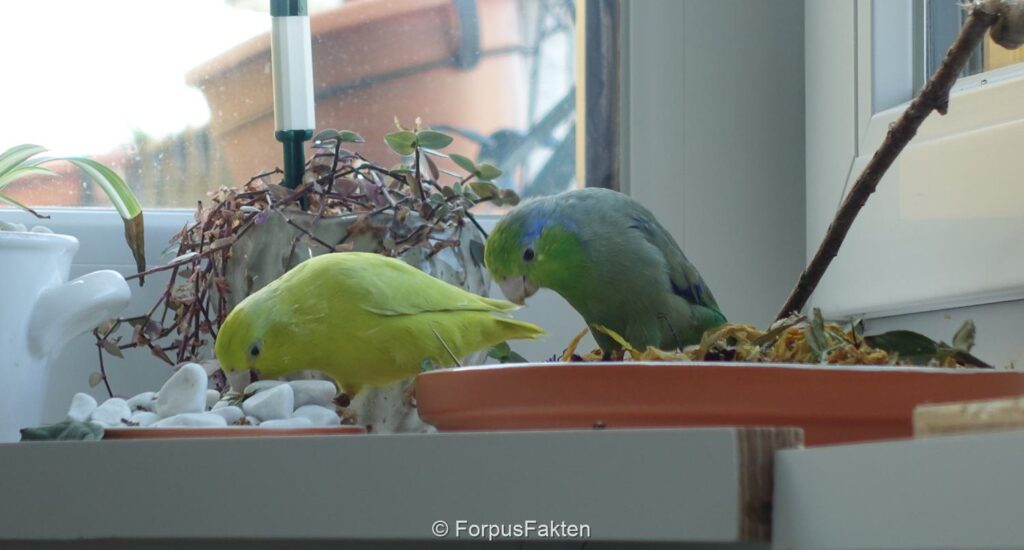
Another option are grasses cultivated in pots or cups. You can also buy pre-cultivated wheat grass or other grasses marketed for cats and rodents in pet shops and stick in grasses or pieces of millet to simulate a seed-bearing meadow.
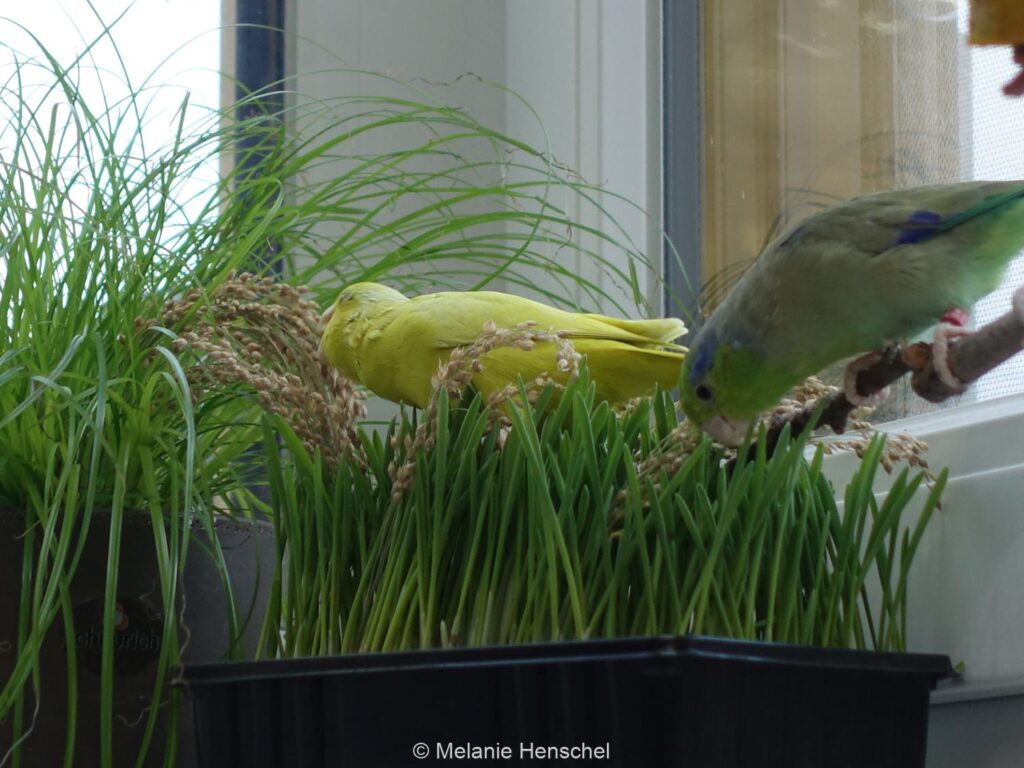
Nibbling on greenery
Besides seeds, birds should also be offered fibrous greenery. If, for instance, you feed half-ripe grasses or millets, the fibre-rich stems are also nibbled. With root vegetables like carrots, radishes or kohlrabi, the leaves are often just as popular as the tuber itself. Even if the leaves and stems are only shredded, they provide a nice enrichment variety. But nibbling the vegetables themselves also falls into that category. Therefore, in general, it is better to feed (fruits and) vegetables in one piece (e.g. on a stainless stell spike) rather than chopped or grated in a bowl.
Flying
Allow your birds not only to experience climbing around trees and twigs but also try to simulate flying from food ground to food ground or tree to tree. You can, for instance, feed the basic diet easily accessible inside the cage while rich treats are supplied in different spots of their free flight area.
Constant variety
Experienced foragers can very well search their food for a while to find out where there is something to get today. At least during your weekly cleaning, you should exchange or at least rotate foraging toys to prevent boredom.
Switching to foraging
For a step-by-step introduction to foraging, you should first offer easier variants like millet on cob or panicle instead of loose millet in the bowl. This should first be offered easily accessible, then in locations that are harder to get to and finally hidden. The hiding places should follow a gradual increase in difficulty as well, e.g. first use an oben container, then cover one third, then half, two thirds and finally completely cover it. Lids should be either removable or shreddable for birds. Suitable materials are e.g. willow mesh, balsa platelets or cork bark. For introducing digging boxes, you can e.g. first but a filled food bowl inside the box and then gradually put more of the food from the bowl inside the box until the empty bowl can be removed.
There is no sure formula
In all of this, one thing is very important to me to mention: Each parrot is different and some things may not work with each bird, pair or flock. I had to painfully experience this myself when my Sunny developed her aggression problems (read more on this in this article). If your birds e.g. only eat their veggies grated, it doesn't make much sense to put in a whole piece on a stick every day, only to throw it out untouched at the end of the day. If your birds do not leave their cage (yet), foraging enrichment all over the room will only collect dust.
Therefore, what is important is the basic idea of varied feeding, both in terms of content and presentation. The points outlined above should be seen less as a to-do list and more as inspiration. Of course, the list does not claim to be complete. I would also be very happy if you shared new ideas with me in the comments or via email.
Sources
Andreas Wilbrand: Futterpflanzen für Vögel: Futter- und Heilfplanzen, Früchte und Süßgräser, Trink- und Badetees. Oertel+Spörer, Reutlingen 2020, ISBN 978-3965550339
Bärbel Oftring & Petra Wolf: Vogelfutterpflanzen aus Natur und Garten – Beliebte Futterpflanzen für Ziervögel und Ziergeflügel Anbau, Ernte, Eignung, Wirkung: Edition Gefiederte Welt. Arndt-Verlag, Bretten 2019, ISBN 978-3945440339
Jörg Ehlenbröker, Renate Ehlenbröker & Eckhard Lietzow: Agaporniden und Sperlingspapageien: Edition Gefiederte Welt. Ulmer, Stuttgart 2010, ISBN 978-3-8001-5431-9
Karl Heinz Spitzer: Sperlingspapageien: Arten und Rassen, Haltung und Zucht. Ulmer, Stuttgart 1992, ISBN 978-3-8334-8551-0
Wolfgang Aeckerlein & Dietmar Steinmetz: Vögel richtig füttern. Ulmer, Stuttgart 2003, ISBN 978-3800135455

